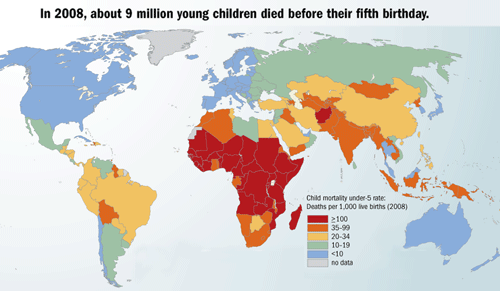Picture This: Reducing Child Mortality
Finance & Development, September 2010, Vol. 47, No. 3
Despite progress, under-5 mortality rates remain unacceptably high
THE under-5 child mortality rate declined by more than 25 percent—from 101 deaths per 1,000 live births to 73 between 1990 and 2008—showing notable progress, but still not enough to meet the Millennium Development Goal (MDG) of reducing child death rates by two-thirds by 2015. In 2006, the number of children who died before age 5 from preventable causes fell below 10 million for the first time, down from 13 million in 1990. The good news is that 10,000 fewer children died each day than in 1990. Even so, the aggregate number is still terribly high, or about one-fifth of the world’s deaths annually. A child in a developing country is still 10 times more likely to die before age 5 than a child in a developed country. This MDG (MDG 4, along with MDG 5 on maternal health) is one of the targets most off track.
Uneven progress

While all regions have made progress in reducing under-5 mortality rates, disparities between and within regions continue to grow. Many countries in sub-Saharan Africa have made little progress. There, one child in seven dies before his or her fifth birthday. This region has 20 percent of the world’s children under age 5 but 50 percent of all child deaths. The odds are a little better in south Asia, where one child in 13 dies before age 5. These two regions continue to be the priorities for preventive interventions, such as immunization, mosquito nets, clean water, and exclusive breastfeeding.
Major causes

Undernutrition is the fundamental cause of over a third of all under-5 deaths. Despite some progress, one in four children under 5 in developing countries is underweight. Children are most vulnerable during their first four weeks of life, when 4 in 10 child deaths occur. Nearly forty percent of all deaths in children under 5 in 2008 were attributable to just four preventable diseases—pneumonia, diarrhea, malaria, and HIV/AIDS.
Progress interrupted

Even before the crisis, progress on reaching the MDG target for child mortality was lagging. Now, as a result of the recent financial and food crises, it is estimated that an additional 1.2 million children under 5 might die between 2009 and 2015. There is hope, however. Thirty-nine countries, which account for half the population of low- and middle-income economies, are on track to reduce under-5 child mortality rates by two-thirds or more by 2015. Some of the poorest countries are overcoming great odds, making remarkable progress in reducing child death rates or the absolute number—namely, Bangladesh, Bolivia, Eritrea, Lao P.D.R., Malawi, Mongolia, Mozambique, Nepal, and Niger.

Prepared by Delfin S. Go. Unless otherwise indicated, text and charts based on Global Monitoring Report 2010: The MDGs after the Crisis, published by the World Bank in 2010. The report is available at www.worldbank.org/gmr2010


